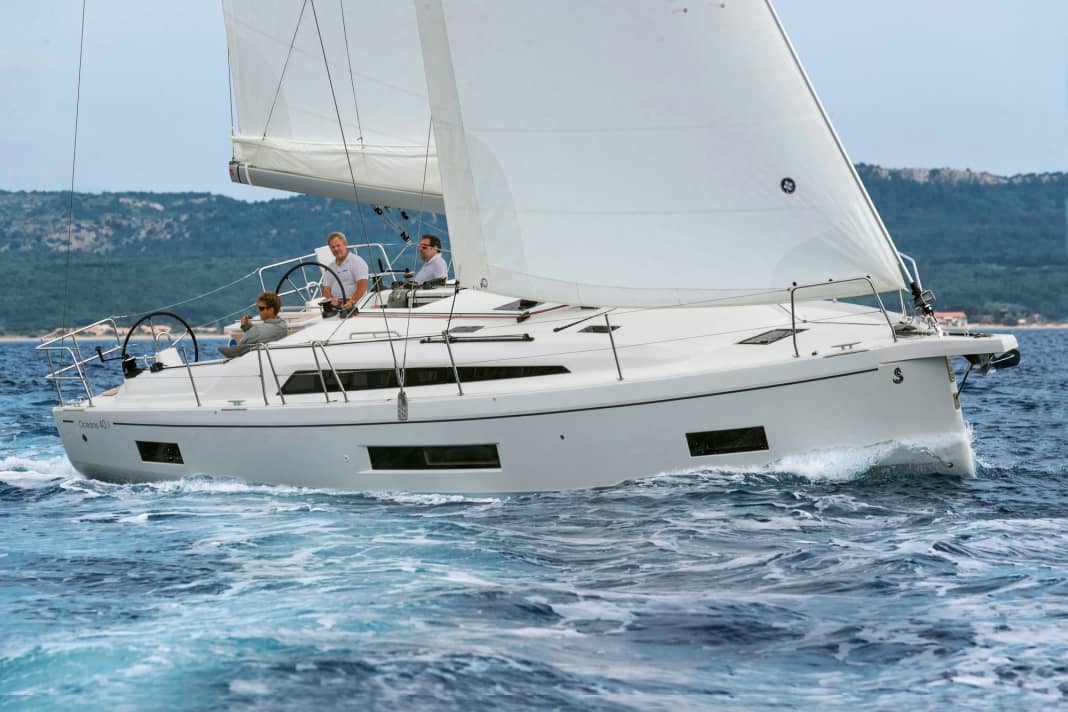





Twelve metres long and four metres wide. This is the format that the major players in the industry have firmly in their sights - the standard size, so to speak, for mid-calibre cruising yachts. The extremely high market relevance of the 40-foot hull length class is due to the fact that the size is of equal interest to both owners and the charter business. The two customer groups more or less share sales between the leading manufacturers in France and Germany.
So it's no wonder that shipyards such as Bavaria, Hanse, Beneteau, Dufour and Jeanneau are investing so much in the development of the twelve-metre segment. In 2020, the remarkable C42 from Bavaria Yachtbau in Giebelstadt. Its direct competitor is the Oceanis 40.1 from world market leader Beneteau, which was launched at almost the same time.
Jeanneau utilises synergies with the Oceanis 40.1
She will be used by Beneteau as the successor to the Oceanis 41 from 2011 and its 2016 update, the 41.1. It should be mentioned that the shipyard awarded the design contract for the ship to the renowned designer Marc Lombard. The predecessor models and the other smaller vessels in the Oceanis series at the time, on the other hand, were designed by the Finot/Conq studio.
Marc Lombard has not yet made a significant appearance as an architect at Beneteau, but has worked all the more for the sister company Jeanneau, where he designed the smaller models in the cruising range, including the fast and very innovative Sun Odyssey 410 which is strikingly similar to the Oceanis 40.1 in terms of appearance, design and concept. It seems as if the two market giants have bundled more synergies than ever before under the umbrella of the powerful Beneteau Group for the development of their 40-footers.
Attractive look with plenty of volume
A striking design feature of the Oceanis 40.1 from Lombard is the distinctive chine in the hull, which runs from the stern to the bow. This means that the freeboard drops vertically over the entire length of the ship and only narrows sharply towards the waterline via a pronounced edge. The look is unusually aggressive, but at the same time attractive. The hull can thus be made even more voluminous with a slender waterline and a correspondingly small, wetted surface in the underwater area.
One beneficiary of this is the interior fittings, for which a significant increase in volume is now available, particularly in the foredeck area and in the saloon, while the dimensions remain the same. On the other hand, the sailing characteristics also benefit thanks to extremely high dimensional stability. A double win in other words.
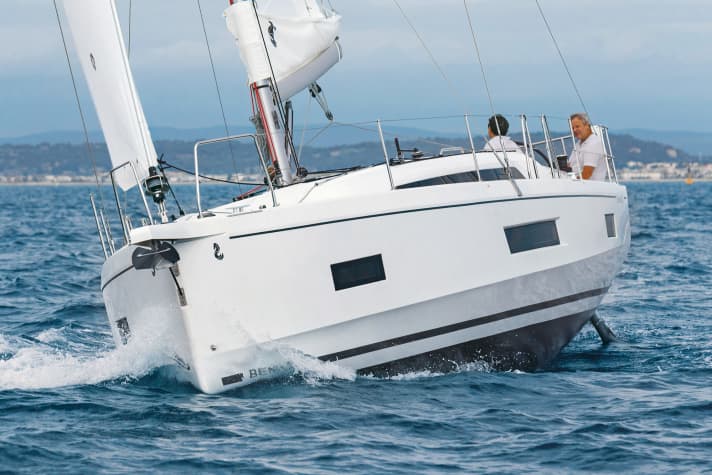
The Oceanis 40.1 shines with good sailing characteristics
In fact, the Oceanis 40.1 is an excellent performer. To prove this, the test area off the harbour town of Gruissan in the south of France offered the best conditions for the YACHT test shortly after the presentation: between 12 and 14 knots of wind from a constant direction, plus a short and steep wave of around one metre in height. Perfect: the test boat, construction number 1, equipped with a simple but beautifully tailored sail wardrobe (main and overlapping genoa made of Dacron), copes excellently. The Frenchwoman cruises hard upwind with good tacking angles of around 80 degrees and logs an average of 7.0 knots. That should also be an announcement for the competition.
The boat sails very stiffly and upright, despite the comparatively low ballast content of just 24 per cent in the cast iron keel with a standard draught of 2.17 metres. The Oceanis 40.1 develops a lot of temperament with half or aft wind under code zero or gennaker. In the test, both additional sails were tried out at the same time; the result was a speed of over 9.0 knots in each case.
Steering is a lot of fun because the boat can be steered very directly and actively with its two relatively large rudder blades and shows no signs of losing control even when deliberately heeling. Despite its voluminous bow section, the Oceanis 40.1 surprisingly has little tendency to pitch. Rather, the boat seems to find its way through and with the waves almost by itself. It is easy for the helmsman to keep the boat in line with the wind at all times. Good marks for the Oceanis 40.1 in terms of its sailing characteristics.
The distinctive Targa bar has been abolished
Buyers are free to decide on the rig configuration. As standard, the boat is delivered from the shipyard with a furling mast and a self-tacking device for the jib. Alternatively, the classic mainsail and an overlapping genoa are available, as on the test boat. For ambitious sailors who want even more performance, the shipyard also offers a sporty upgrade as part of the package. This includes a longer mast with a backstay cascade, higher-quality sails, better fittings, Dyform shrouds and Dyneema running rigging, among other things.
The predecessor models Oceanis 41 and 41.1 are visually characterised by the tarp bracket above the cockpit. The solid frame has many advantages, such as the fact that the mainsheet is no longer guided from the cockpit, or as a solid base for a cockpit awning or a larger bimini. However, the anchoring in the superstructure is accompanied by complicated reinforcements and a not inconsiderable additional weight. The new Oceanis 40.1 therefore no longer has a tarp bracket, even as an option. The mainsheet is now run via a sheet triangle in front of the companionway, which in principle works just as well for trimming the mainsail. However, because the sheet engages further forward on the main boom, more force is required to take out the seal. Electric winches can make handling easier here and can be ordered as an option.
Focus on easy handling with the Oceanis 40.1
Otherwise, the layout remains pleasingly simple and clear. Even beginners will quickly find their way around the boat. Only the genoa sheets and the lines for the optional centre of gravity adjustments are led aft to the two winches in front of the steering columns, which can be easily reached and operated both from the cockpit and by the helmsman. The mainsheet, halyards and all trim lines are routed via the cabin superstructure to the winches on both sides of the companionway - a very common and proven arrangement, but one that also makes the boat unsuitable for single-handed sailing and makes the purchase of an autopilot unavoidable for soloists. However, if you wish, you can also have the mainsheet deflected aft on both sides as a German cupper system; this option is already offered by the shipyard.
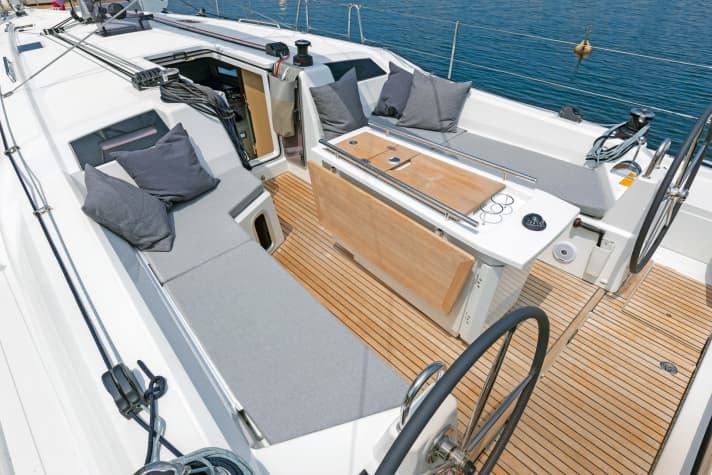
Following in the footsteps of the competition from Dufour and Jeanneau, Beneteau has now also set the main boom very low at the front of the mast on the new Oceanis 40.1. This makes handling the mainsail more effortless and the cloth is easier to reach for bagging in the lazybags, even without a dangerous climb. Both the sail pressure point and the centre of gravity are lowered quite a bit, which is beneficial for performance and sea behaviour.
However, the main boom rising aft takes some getting used to visually. Because the boom vang engages at quite an acute angle to the boom, it requires more force to operate and also requires stronger fittings to be able to handle the high loads.
The control mechanism is simple but unsafe
In the cockpit, the 1.85 metre long thwarts are just long enough for sunbathing and stretching out. Leaning back is uncomfortable, however, because the cabin bulkhead is angled upwards and forwards to make way for a light window to the aft cabins - a compromise. In favour of the long thwarts, the steering columns are built quite far aft, leaving comparatively little space and freedom of movement for the helmsman. What's more, if the helmsman is sitting sideways and not standing, he will have the pulls of the split backstay at his back.
A single continuous Dyneema cable controls the transmission from the two steering wheels to the double rudders or to the push rod that connects the two rudder quadrants. The system has a very simple design and offers pleasingly little mechanical resistance. This means that the control cable can be tensioned more tightly, which reduces slippage in the system without compromising the good, direct steering feel.
The disadvantage of this is that in the event of a defect on the control linkages or a break in the fittings, the steering immediately becomes completely ineffective. Then only the emergency tiller or - if available - the autopilot, whose hydraulic cylinder is directly connected to one of the two rudder quadrants, can help. Incidentally, the steering mechanism on the Oceanis 40.1 is easily accessible for maintenance and repair through the aft peak and through inspection hatches in the aft bulkhead of the aft cabins.
Unfortunately, the aft peak can only be used to a limited extent as additional storage space, because the many components of the on-board technology are installed openly at the rear and stowage items tumbling around could damage and block the mechanical parts. Partitions or, even better, storage boxes would be desirable at this point. Six fenders can be stowed in the anchor locker at the front, while mooring lines, shore power cables and similar items can be stored in the two lockers in the cockpit. These are also large enough to accommodate additional sails such as a code zero or gennaker, but only if they are packed neatly and tightly.
Up to ten people can stay overnight on the Oceanis 40.1
With a hull length of 40 feet, a sail load in the foredeck is also not common on competitor boats, only in the next larger class around 45 feet. Owners can therefore consider having their Oceanis 40.1 fitted with a large and accessible forecastle instead of the second aft cabin on the port side, for example to stow things there for a long journey. This is a possible variant for the extension below deck.
Additional variance is offered by the option of having a second toilet room installed in the foredeck. Thanks to the enormous amount of space there, Beneteau can even install a further, separate cabin with two bunks in its twelve-metre tourer, which can be accessed directly from the saloon via a second door in the main bulkhead. Judging by the layout plans, however, it is likely to be quite cramped in there with double occupancy.
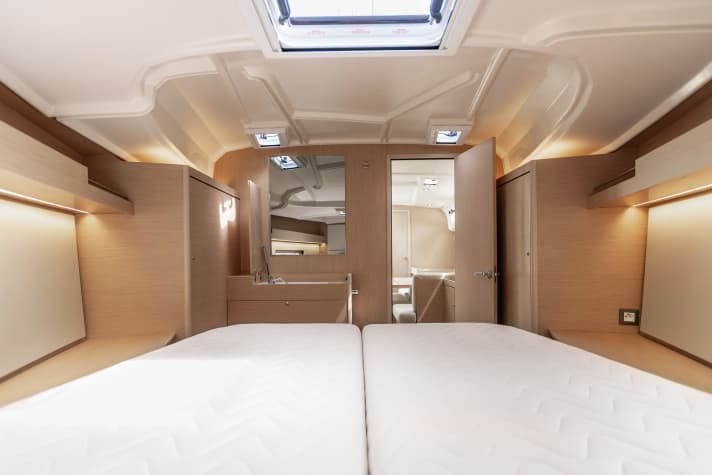
The layout with up to four double cabins and two heads compartments is exclusive to Beneteau within the size segment and will therefore meet with keen interest from charter operators in particular. In addition, the table in the saloon can be lowered and the generously proportioned seating area can be converted into a double bed. This means that the Oceanis 40.1 could theoretically sleep up to ten people overnight.
The interior is wide, open and flooded with light
In the standard ex-shipyard version, the boat comes with a comparatively spacious forward cabin with an island bed and two spacious wardrobes. An additional piece of furniture with an integrated washbasin is attached to the main bulkhead - a good idea for better separation of the living areas when several people are staying on the boat.
The layout of the saloon is new, with a very spacious galley in an open U-shape on the starboard side, which offers plenty of work surface and storage space. Overall, the saloon is wide, open and flooded with light. The interior fittings with light-coloured oak wood contribute to the generally inviting and friendly living atmosphere. As a variation, the shipyard can also use a darker walnut wood for the interior, and floors in different colours and textures can be combined.
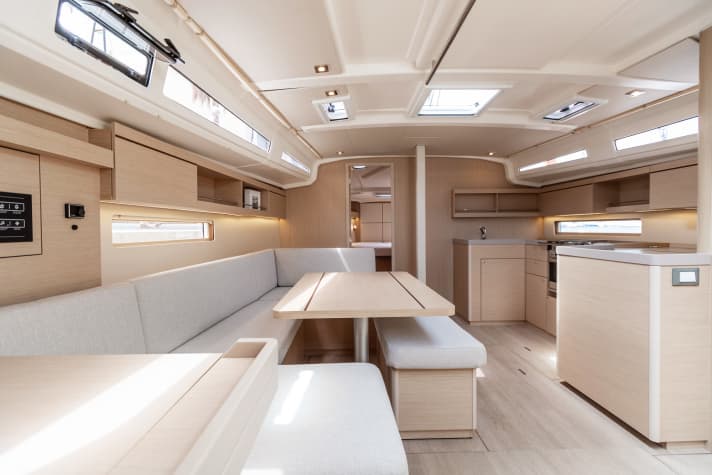
The boat can be ventilated via many large deck hatches in the saloon and forward cabin. In the wet room and in the aft cabins, however, ventilation is unfortunately only possible to a limited extent; there are no larger openings or hatches for cross ventilation. Some inconsistent gap dimensions when fitting the furniture and floorboards and some unsightly finishes, especially in parts of the ship that are not visible at first glance, spoil the otherwise very good overall impression of the standard of fittings.
The deck of the Oceanis 40.1 is manufactured using the complex RTM (Resin Transfer Moulding) vacuum injection process, which ensures dense and robust structures with clean surfaces (exterior and interior) as well as good sound and thermal insulation. The main advantage of this method, however, is that no additional inner shells or ceiling panels are required below deck, thus reducing weight and additional costs during construction. The hull of the 40.1 is built as a solid GRP full laminate in hand lay-up.
With its innovative design and honest, straightforward orientation, the Oceanis 40.1 is built on a solid foundation for a particularly competitive class. Beneteau has always served this segment very successfully. The Oceanis 40.1 follows on from this.
The predecessor: Oceanis 41/41.1
It is not an easy legacy for the new Oceanis 40.1 from Beneteau to inherit. After all, the predecessor model achieved an almost four-digit number of units in just under ten years on the market and achieved record sales. The best-selling Oceanis 41 was built around 450 times, while the revised version Oceanis 41.1 was launched a further 400 times. Its specific feature is the massive targa bar above the cockpit, which has been removed from the successor. And the older model has only one rudder blade with a significantly less wide stern.
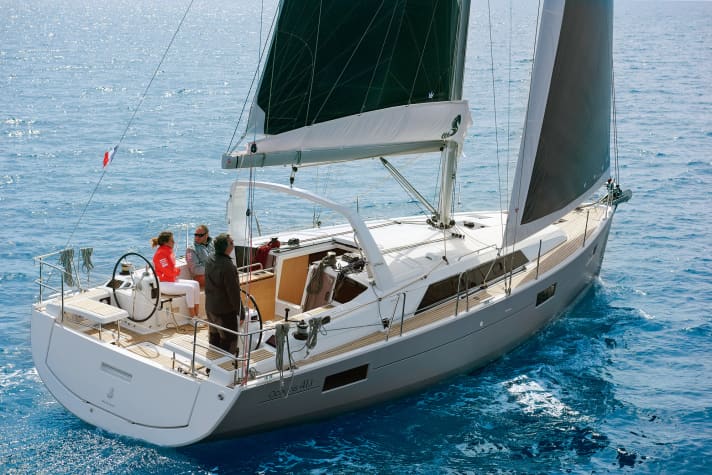
Although the hull of the predecessor model is around two centimetres wider than the successor ship with the same length, the perceived volume of space below deck is hardly comparable. This clearly shows the effects and advantages of the new, modern hull shapes, which allow the designers to approach and realise unconventional layouts.
The Oceanis 41, on the other hand, is still characterised below deck by the classic arrangement with two benches to the side of the saloon and a significantly smaller L-shaped galley to the side of the companionway compared to the 40.1. Today, the Oceanis 41 and 41.1 models are well represented on used boat portals and are also widely offered on yacht charters worldwide.
Measured values Oceanis 40.1
Sailing performance, without drift and current
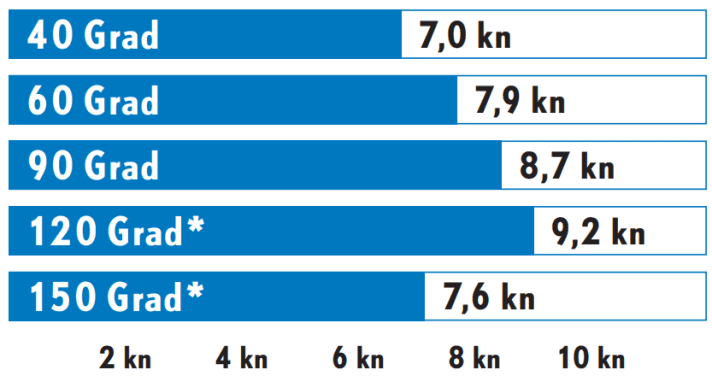
Wind speed: 14 kn (4 Bft.), wave height: approx. 1.0 metres
* With gennaker
Potential

With the standard self-tacking jib, the sail carrying capacity is rather modest
1: Dimensionless number. Calculation: 2√S/3√V. The higher the value, the more sail area (S) the ship has in relation to the displacement (V).
Berth dimensions
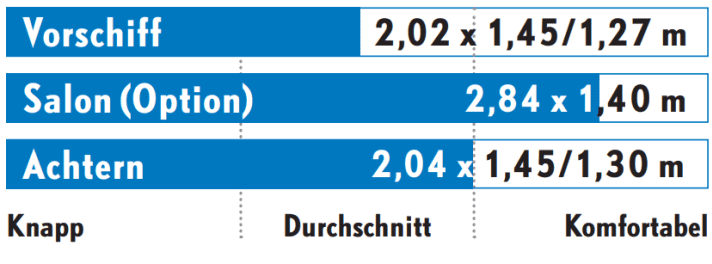
Standing height
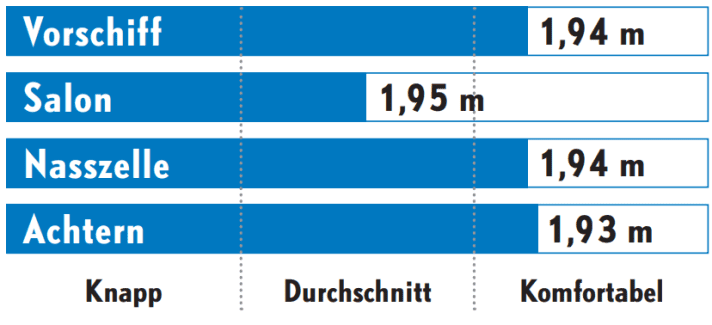
Sound pressure
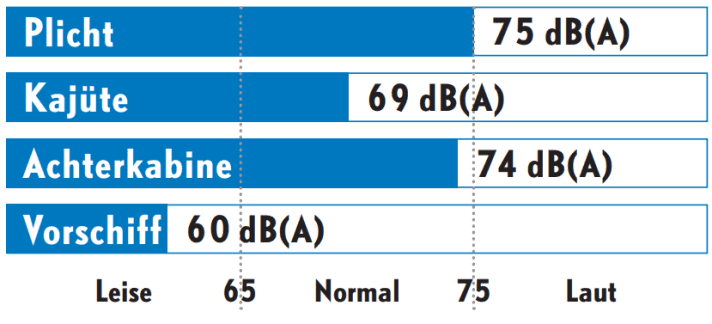
Measured at cruising speed (80 % of maximum speed): 6.6 kn, 2560 min-1
Technical data Oceanis 40.1
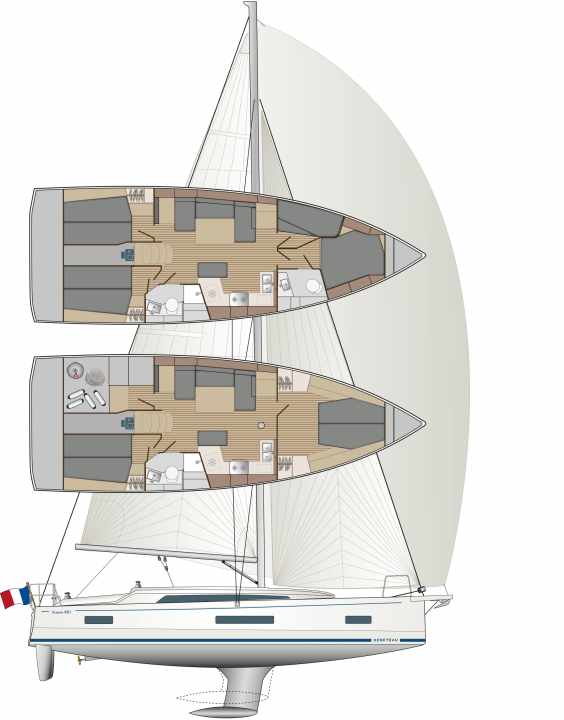
- Designer:Marc Lombard
- CE design category:A
- Torso length: 11,99 m
- Total length: 12,87 m
- Waterline length:11,70 m
- Width:4,18 m
- Draught/alternative: 2,17/1,68, 2,27 m
- Theoretical torso speed: 8.3 kn
- Weight: 8,2 t
- Ballast/proportion: 2,0 t/24 %
- Mast height above waterline:18,33 m
- Mainsail: 42,4 m2
- Self-tacking jib: 27,4 m2
- machine (Yanmar): 33 kW/45 hp
- Fuel tank:195 l
- Fresh water tank:235 l
- Holding tank: 50 l
Hull and deck construction
- Hull:GRP solid laminate using the hand lay-up method.
- Deck: GRP sandwich construction with foam core, built using vacuum injection (RTM)
Base price ex shipyard
273,462 euros gross incl. 19 % VAT (as at July 2023)
YACHT review Oceanis 40.1
The radical hull lines with the extreme upturned centreline allow a volume inside that other boats in this class can hardly offer. Up to four cabins and two toilet rooms are possible. The Oceanis 40.1 can also impress under sail
Design and concept
- + Innovative design with plenty of volume
- + Robust deck construction
- - Little sail area in the standard version
Sailing performance and trim
- + Runs high and fast on the wind
- + Balanced control
- + Very easy handling
Living and finishing quality
- + Luxurious forward cabin
- + Numerous expansion options
- - Minor defects in detail processing
Equipment and technology
- + Varied sailing plan
- - Control mechanism without safeties
- - Partially restricted ventilation
This article first appeared in YACHT 17/2020 and was revised for this online version in July 2023.

